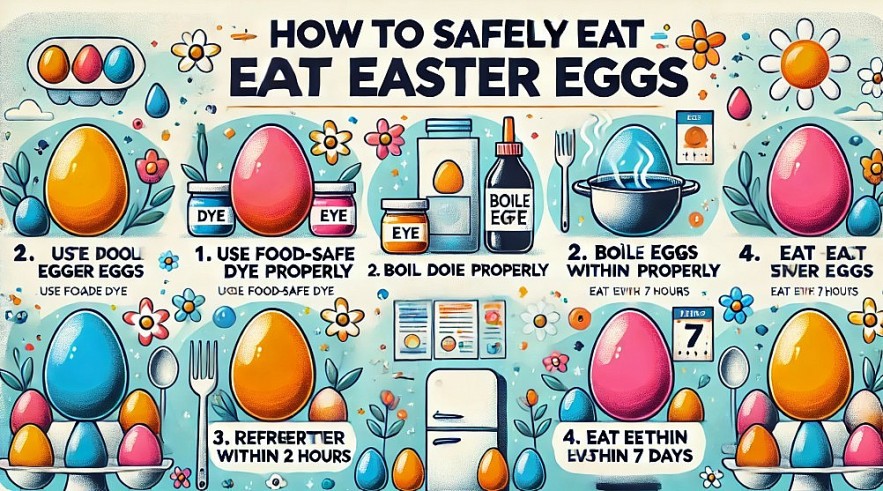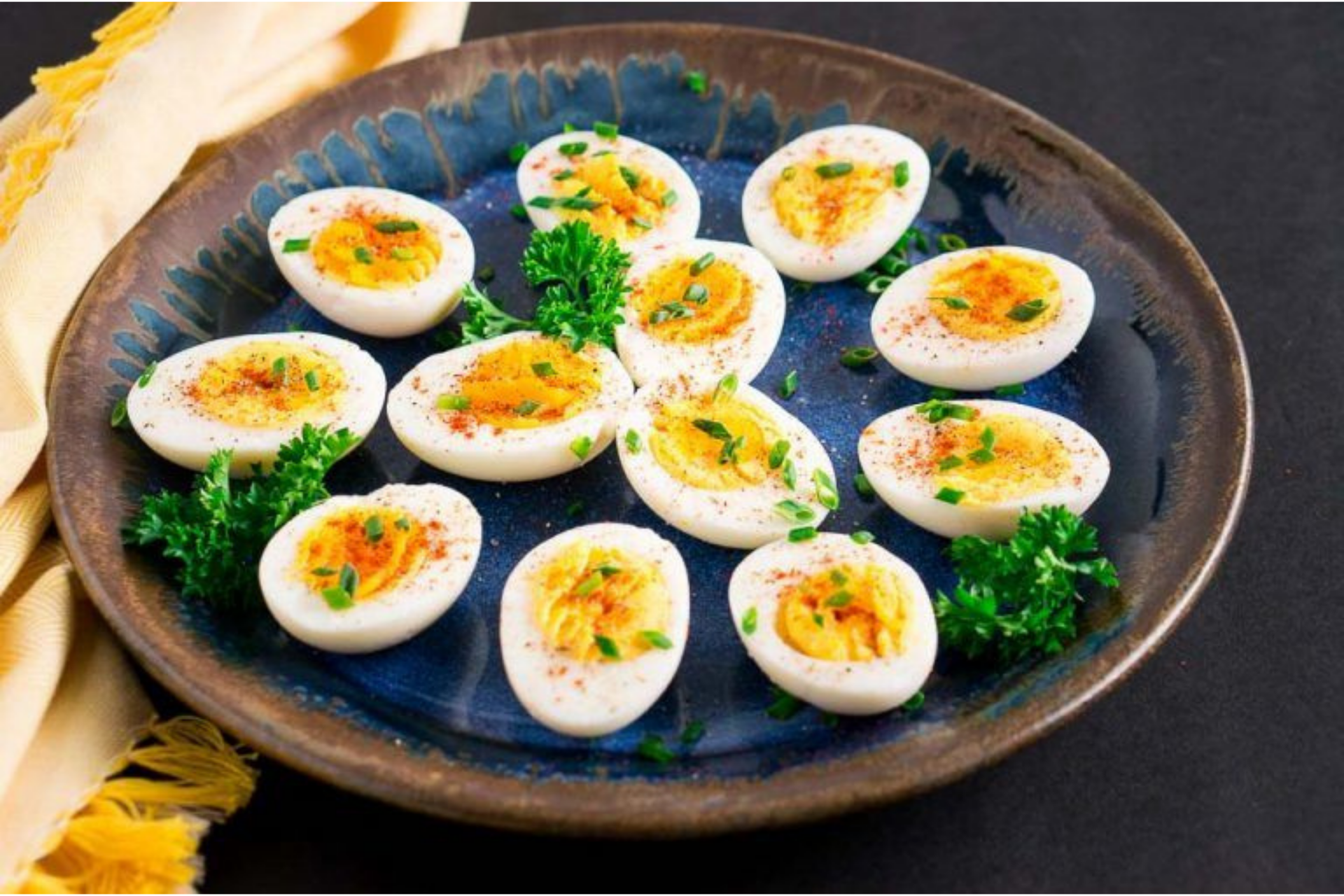Can You Eat Dyed Easter Eggs? The Ultimate Guide to Safety, Storage, and Smart Tips
 Why Should You Avoid Storing Eggs in the Refrigerator Door? Why Should You Avoid Storing Eggs in the Refrigerator Door? |
 How Much Is A Dozen and A Half Dozen - Definition, Origins and Facts How Much Is A Dozen and A Half Dozen - Definition, Origins and Facts |
Each spring, colorful Easter eggs brighten up baskets, tables, and lawns. But after the egg hunt is over, one practical — and important — question comes up: Can you eat dyed Easter eggs?
The short answer: Yes, you can — but only if they've been handled correctly. In this detailed guide, we'll walk you through everything you need to know to safely enjoy dyed Easter eggs: which dyes are food-safe, how to store them, common mistakes to avoid, and expert food safety tips.
Can You Eat Dyed Easter Eggs?
 |
| Can You Eat Dyed Easter Eggs |
Yes, dyed Easter eggs are safe to eat — as long as:
-
You used food-safe dye
-
The eggs were properly cooked
-
They were refrigerated quickly
-
They haven’t been left at room temperature for more than 2 hours total
Just because an egg looks pretty doesn’t mean it’s safe to eat. The good news is, with the right steps, your decorative eggs can also be a tasty, protein-packed snack.
What Types of Dye Are Safe to Eat?
Using the right dye matters. Not all dyes are meant for food. Here’s what’s safe — and what to avoid:
Food-Safe Dyes:
-
Liquid food coloring mixed with vinegar: This common method is 100% edible.
-
Commercial Easter egg dye kits labeled “food-safe” or “non-toxic”: Safe if used as directed.
-
Natural dyes: Ingredients like beet juice, turmeric, purple cabbage, spinach, and onion skins not only create beautiful colors but are safe for consumption.
Avoid:
-
Acrylic or craft paints
-
Permanent markers
-
Glitter glue
-
Any product not explicitly labeled as food-safe
If you’re unsure whether a product is food-safe, it’s best to err on the side of caution—especially if the eggshell is cracked.
How to Properly Boil and Dye Easter Eggs for Eating
To make sure your dyed Easter eggs are safe to eat, follow these best practices from food safety experts.
Start with Fresh Eggs
Buy eggs no more than a week before boiling. Always inspect for cracks before boiling—cracked eggs can allow bacteria inside.
Boil Correctly
-
Place eggs in a single layer in a saucepan.
-
Cover with cold water by about an inch.
-
Bring to a boil over medium heat, then turn off heat and let sit covered for 10–12 minutes.
-
Transfer immediately to a cold water bath to stop cooking.
Dye With Care
-
Use clean containers and utensils for dyeing.
-
Avoid reusing cups or bowls used for non-edible crafts.
-
Wash your hands thoroughly before and after handling the eggs.
Storage Rules: How Long Are Dyed Easter Eggs Good For?
Refrigerated (Unpeeled)
Safe to eat for up to 7 days.
Peeled Eggs
Best consumed within 2–3 days.
Room Temperature
Unsafe if left out for more than 2 hours total—this includes time during dyeing, displaying, and hunting.
If you’re using eggs for decoration or an egg hunt, keep them cool or minimize the display time. For outdoor hunts, consider using plastic eggs instead of real ones, especially in warm weather.
 |
| Dyed Easter Eggs |
Can You Eat Eggs That Were Hidden Outside?
Only if they’ve been outside for less than 2 hours and temperatures stayed below 70°F (21°C).
Outdoor egg hunts increase the risk of contamination from dirt, bacteria, animals, and sunlight. If you're not confident about how long the eggs were out or their exposure conditions, it's safer to discard them.
Cracked Eggs: Eat or Toss?
Cracked eggs pose a food safety risk. If the egg cracked before or during dyeing, and the shell was exposed to dye or air, it may be contaminated.
-
If you're unsure when the crack occurred: Discard it.
-
If the crack happened after cooking and the egg was immediately refrigerated: It may still be safe for up to 1–2 days.
 |
| Can You Eat Dyed Easter Eggs |
Bonus: What to Do With Leftover Dyed Eggs
Don’t waste your dyed Easter eggs once the holiday fun is over. Here are a few delicious and practical ideas:
-
Make egg salad for sandwiches or wraps
-
Prepare deviled eggs for snacks or parties
-
Add slices to salads like Cobb or Niçoise
-
Enjoy with a sprinkle of salt and pepper
-
Pickle them for extended shelf life
Just remember: only use eggs that have been stored properly and are within the safe consumption window.
Quick Safety Checklist
 |
| Quick Safety Checklist |
Final Word: Can You Eat Dyed Easter Eggs?
Yes — but only with the right prep, handling, and storage. Treat dyed eggs like any other perishable food. Use food-safe dyes, boil and cool them properly, refrigerate promptly, and eat them within the safe time window.
By following these simple rules, you can fully enjoy the fun and flavor of this Easter tradition—safely.
 How to Boil Eggs in Different Styles? How to Boil Eggs in Different Styles? Learn the best method for how to boil eggs to produce the perfect hard boiled egg every single time without any fuss. |
 How Many Calories Are In 2 Eggs? How Many Calories Are In 2 Eggs? Eggs are a protein and nutrient powerhouse. They can be added to many dishes and prepared in numerous ways. How many calories are in 2 ... |
 How To Preserve Eggs With Rice and Cooking Oil for 6 Months Without Refrigeration How To Preserve Eggs With Rice and Cooking Oil for 6 Months Without Refrigeration Preserve eggs easily with one of these safe and effective ways to make them last months and even years longer! |
 What is the Century Eggs (Preserved Duck Eggs) - The World's Weirdest Dishes What is the Century Eggs (Preserved Duck Eggs) - The World's Weirdest Dishes Century egg is unquestionably one of the most bizarre dishes on the planet. This article by KnowInsiders.com will reveal the origins of this type of ... |























